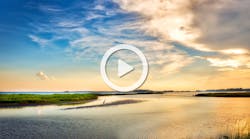Seagrass Transplants to Restore Fish Habitat in Florida Lagoon
Atkins’ environmental experts have transplanted seagrass along the bottom of the Indian River Lagoon as part of a three-year experimental test program to restore the once-lush fish habitat near Sebastian Inlet on Florida’s east coast. According to the St. Johns River Water Management District, each acre of lagoon seagrass supports about 10,000 fish and $5,000 to $10,000 in economic activity in the region.
The Indian River Lagoon is one of 28 National Estuary Program waterways in the U.S. A popular boating and fishing destination, the lagoon is also one of the most biologically diverse estuarine ecosystems in North America and supports hundreds of species of fish, birds, plants and animals.
Seagrasses are flowering plants that exist from the mid-intertidal depth range down to depths of 30 meters or more in extremely clear water. Seagrass beds offer a variety of benefits, such as providing a nursery for juvenile fish and crustaceans, serving as a food source, stabilizing the bottom sediment and improving water quality and clarity.
From 2010 to 2012, the northern and central portions of the Indian River Lagoon experienced region-wide seagrass losses of some 32,000 acres to harmful algal blooms and other environmental factors. The transplanting program will help to determine if seagrass can thrive again.
Atkins’ scientists harvested shoal grass, a rapidly growing seagrass, from a donor site using only hand tools and then manually installed the grass at the recipient study sites. Atkins also mounted metal cages over portions of the transplant areas as an extra step to protect the seagrass from being eaten by manatees and turtles that inhabit the lagoon.
In 2007, the Sebastian Inlet District completed construction of a new navigation channel connecting the Inlet to the Intracoastal Waterway to provide the growing maritime community with a safe, clearly designated passage to and from the Atlantic Ocean. Since then, Atkins’ scientists have administered a comprehensive seagrass mitigation and monitoring program to help offset the channel’s impacts to seagrass habitat in the Indian River Lagoon. State and federal permitting agencies have referred to this program as being a model for seagrass mitigation programs.
Source: Atkins


